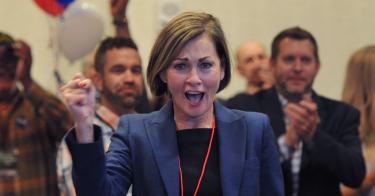State lawmakers are often slow to act, but they can move quickly when voters make them feel the heat. Consider Iowa, where Gov. Kim Reynolds recently signed the nation’s third publicly funded education choice program for all K-12 students, following West Virginia and Arizona.
This represents a stunning reversal. A smaller proposal failed to clear the legislature last year. What changed?
The Students First Act will provide Iowa families education savings accounts (ESAs) that they can use for private school tuition, tutoring, textbooks, curricular materials, and a variety of other education expenses. The ESAs, funded with a portion of the state’s per-pupil spending, are worth about $7,600 annually. That more than covers the average private elementary school tuition in Iowa (about $5,400) and nearly covers the average private high school tuition (about $9,200).
Families can also roll over unused ESA funds from year to year to save for later expenses. Initially, the ESAs will be available to low- and middle-income families; they will open to all Iowa families in the program’s third year.
The policy Reynolds signed is significantly more ambitious than her proposal last year, which was limited only to low-income students. That bill cleared the state senate but failed after a lengthy battle in the Iowa House of Representatives. Although the GOP had strong majorities in both chambers, several Republicans representing rural areas raised concerns about the effects that school choice policies might have on their local public schools.
>>> What’s Behind the Recent Surge in School-Choice Victories
Last spring, Reynolds took the unusual step of endorsing several primary challenges to legislators in her own party who had thwarted her school choice proposal. The governor was betting that she had a better understanding of the GOP base’s priorities than the legislators she was challenging—politicians who had already proven their popularity in their districts. If they survived their primary challenges, Reynolds’s standing in the party would be significantly diminished.
Rural Republican legislators nationwide have long posed a stumbling block to passing school choice legislation. In rural areas, public schools are often the largest employers, and the local superintendents wield significant political power. Rural legislators therefore tend to heed those superintendents’ hostility to expanding school choice.
But in the wake of the COVID-19 school shutdowns, the relationship between parents and their local schools changed. "We wouldn’t have passed the ESA bill but for COVID," explained Iowa Sen. Brad Zaun, a long-time proponent of school choice. "Groups like Moms for Liberty were down at the capitol nearly every day clamoring for school choice."
But they didn’t become school choice supporters overnight. Initially, parents just wanted their local public schools reopened. Some districts—including in Des Moines, the largest in the state—stayed closed for in-person instruction for more than six months. Frustrated parents turned to the governor and their state legislators for help. Lawmakers ultimately forced schools to reopen.
But the shutdown fight had permanently changed the relationship between parents and their local schools. Many parents felt that the schools had broken faith with them. Parents were also given a window into their children’s classrooms via Zoom, and many didn’t like what they saw, particularly the politicization of instruction.
Even after schools reopened, parents remained wary and engaged. Samantha Fett, the Warren County chapter chair for Moms for Liberty, described how her group first got involved trying to remove books with sexually explicit scenes and images from elementary school libraries. "The public school administrators and school boards would just ignore us and hope we’d go away," she said.
But they didn’t. Instead, they again turned to state lawmakers. "The frustration we had the local level not making any progress, not getting any answers, and being pushed away, drove us to look for solutions outside the district system," said Fett.
>>> Protecting Parents’ Rights with the Given Name Act
Soon the parents’ groups were barraging the legislature with complaints. Inappropriate books. Lessons derived from critical race theory. Policies that put biological males on girls’ sports teams and in girls’ locker rooms. Policies kept parents in the dark about their children being called pronouns that differed from their sex.
"Schools they trusted all these years were usurping their authority as parents and they didn’t like it," said Iowa Senate President Amy Sinclair. At first the legislature tried dealing with each issue as it arose, but eventually state lawmakers offered a comprehensive solution: school choice.
"The legislature got tired of playing whack-a-mole with all the issues," said Sinclair. "School choice solved all of them at once."
Parent groups enthusiastically embraced school choice policies, like ESAs, which not only gave them the ability to choose schools that aligned with their values, but also strengthened their hand when raising concerns at their local public schools.
Reynolds also expressed these concerns on the campaign trail, explicitly framing her push for school choice as an effort to combat the radical ideology that had seeped into the public school system and to restore parental authority in education. Her gamble paid off. The candidates she endorsed won their primaries. In the general election, Iowa voters rewarded her with a second term and expanded the Republican party’s legislative majority.
Lawmakers got the message. Last month, they moved with all deliberate speed to deliver the choice bill to Reynolds’s desk.
Lawmakers in other states would be wise to follow Gov. Reynolds’s playbook.
This piece originally appeared in Fox News




